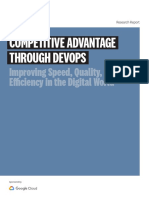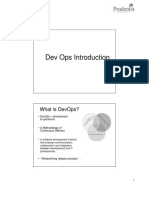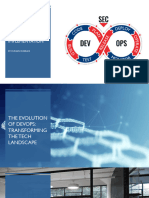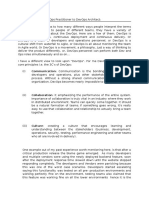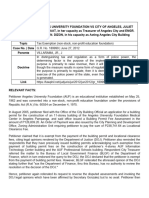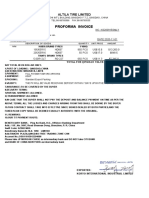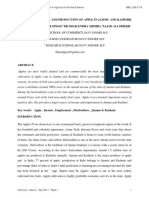lOMoARcP SD| 30 49 728 2
UNIT- V
Devops Maturity Model: Key factors of DevOps maturity model, stages of
Devops maturity Model, DevOps maturity Assessment.
Understanding DevOps Maturity
By definition, DevOps Maturity is described as a model that determines an
organization’s standing in principles of DevOps journey along with
deciding what more to be accomplished to achieve the desired results.
Understanding DevOps adoption ‘as a continuous journey, not a
destination’ stands crucial to achieving DevOps maturity.
The majority of DevOps monitoring solutions are compatible with on-
premise, cloud, and containerized infrastructure, which ensures a
smooth DevOps transformation process.
The DevOps maturity model determines growth through continuous
learning from both teams and organizational perspectives. More the
capabilities and skills, more will be the ability to handle issues of scale and
complexities.
Organizational DevOps maturity can be gauged by their abilities
in the following four areas:
1) Culture and Strategy
DevOps has to be understood as a culture-driven approach that brings
together different teams, driving them towards a common objective.
Transition to DevOps operating model means a transformation in the
organization’s operating culture backed by a set of policies and process
frameworks. So, that needs proper planning and perfect strategy.
2) Automation
Automation is key to continuous delivery and continuous
deployment tools in the DevOps process. By automating repetitive tasks,
the automation process eases development, testing and production in a
DevOps cycle, thus saving time and enhancing resource efficiency.
3) Structure and Process
Modern-day IT functioning is process-oriented and involves processes
across all stages of the Software Development Life Cycle (SDLC). This has
2
� lOMoARcP SD| 30 49 728 2
advanced in a DevOps environment, where every stage is a set of
procedures in line with corporate policies and business objectives.
4) Collaboration and Sharing
This is the most critical aspect of principles of DevOps culture.
Collaboration and sharing are key to DevOps and teams (on the same
location or a different location) will need to align tools and resources
towards achieving common goals and objectives.
Organizations commonly find themselves in one of the following
stages as part of their DevOps operational model journey:
• Unconscious incompetence: Organizations fail to
understand DevOps challenges and its advantages
• Conscious incompetence: Organizations still see siloed processes
even after 12-18 months of DevOps journey with some automation
• Conscious competence: After four years of DevOps
implementation journey and successful automation, organizations
focus on collaboration across teams and streamline sharing
mechanism
• Unconscious competence: Here, organizations are all set with
structured frameworks, in-depth collaboration, the concrete process
for effective sharing
DevOps Maturity Model
A perfect DevOps maturity model determines DevOps maturity in three
ways:
• Assessment of the current state of capabilities
• Identifying areas of improvement
• Outlining steps to achieve desired DevOps goals
In line with these three steps, the DevOps maturity block verifies maturity
in building, deploying and testing stages across application, data and
infrastructure levels:
1) DevOps Maturity for Application – Determines DevOps maturity by
the ease in code movement from Development to Production phase.
Achieving this requires having builds, tests, code coverage, security scans
and monitoring as automated components of the deployment pipeline.
3
� lOMoARcP SD| 30 49 728 2
2) DevOps Maturity by Data – Determines DevOps maturity by ability
to clear path to automate changes to data and validate functionality
regularly, through DataOps.
3) DevOps Maturity by Infrastructure – Determines DevOps maturity
by ability to ease infrastructure using capabilities around automation,
streamlining and enabling self-service to provision environments, among
other tasks.
Key Factors of DevOps Maturity Model
1) Automation
Automation is the buzzword of DevOps culture. DevOps places a high
reliance on automation. Automation involves the deployment of several
technologies to facilitate faster execution of the various functionalities
that are a part of the software development cycle.
The deployment of automation also accelerates the transmission of
updates and feedback among the multi-functional teams. Automation thus
emphasizes minimizing the need for human beings to manually intervene
in the operations associated with software development.
In fact, major DevOps processes like continuous integration, continuous
delivery, and log analytics can be accomplished manually. But it will be at
the expense of additional overheads in terms of communication,
coordination, and time consumption. Automation facilitates faster
execution of several operations as well as thereby guaranteeing better
efficiency and time savings.
2) Collaboration
Collaboration is what enables the transformation of business ideas that
are in their nascent stage into reality. DevOps collaboration is all about
enhancing the quality and efficiency of the software development life
cycle (SDLC) by ensuring that all the multi-functional teams and their
members are efficiently kept in the loop as far as the transfer of
information is concerned.
Information handoffs enable an organization to quickly act on any critical
issues like bugs, errors, and other glitches.
3) Culture and Organization
DevOps is viewed as a cultural shift. To ensure the success of DevOps it is
important to get the entire organization, from the top-level management
leaders to the employees to be on the same page.
4
� lOMoARcP SD| 30 49 728 2
Culture and organizational change is the biggest roadblock to DevOps
transformation as per a 2022 report by Gartner. Once everyone in an
organization is convinced of the need to adopt a DevOps culture, the
transformation to it will be more smooth and more successful.
4) CI/CD
Continuous integration and continuous delivery/ deployment emphasize
delivering higher quality software and facilitating bugs to be identified in
the early stages of the development cycle by testing them earlier on.
CI/CD is identified as a linchpin component of the DevOps strategy. It is
good to consider deploying these practices that help in faster
identification of issues as compared to deploying manual techniques and
resulting in wastage of time. A scalable pipeline enables new
requirements and features to be added easily.
5)Processes
Most organizations have now become largely process-oriented with
functionalities being available for accomplishing A to Z of the multitude of
processes in an organization. Unlike in the past when many processes
were often required to rely on some specific sets of tools, today we have
dedicated tools for accomplishing multiple processes and operations.
Hence it is important to identify an apt tool depending on the nature of a
process to ensure the success of the DevOps strategy.
Summarized, DevOps Maturity model involves five transformation
stages:
5
� lOMoAR cPSD|30 497 28 2
1) Stage-1: Initial
Traditional environment with Dev and Ops separated is handled.
2) Stage-2: Managed
The beginning of change mindset focused on agility in Dev and initial
automation in Ops, with emphasis on collaboration.
3) Stage-3: Defined
Organization-wide transformation begins with defined processes and
established automation.
4) Stage-4: Measured
A better understanding of process and automation, followed by continuous
improvement.
5) Stage-5: Optimized
Achievements are visible, team gaps disappear, and employees gain
recognition.
While these 5 stages make a complete DevOps maturity model, it’s
imperative for enterprises to keep checking their maturity at every step,
and eventually identify focus areas and ways to evolve in the overall
journey.
6
� lOMoARcP SD| 30 49 728 2
Measure in a DevOps Maturity Model
There are a set of parameters to be measured at every stage of the
DevOps Maturity Model to confirm an organization’s level of DevOps
maturity. These measures ideally define the direction the organization is
advancing in its DevOps implementation journey. They are:
• Number of completed projects and the release frequency should
ideally high resulting in ROI
• Percentage of successful deployments should maintain an edge over
unsuccessful ones
• Mean Time To Recovery (MTTR) from an unexpected incident/failure
from the time of occurrence, should be nil or as low as possible
• Lead time, from development of code to deployment in production,
should be satisfactory
• Deployment frequency to determine the frequency of new code
deployments
The stage-wise process and the above parameters define an
organization’s DevOps maturity success.
DevOps Maturity Linked to Security
DevOps maturity is directly linked to DevOps security. As organizations
progress in DevOps journey, the competitive edge becomes a pressing
demand calling for faster release cycles and digital innovation demands a
strong pitch.
Development, operations, and security are the three words that make up
the DevOps security concept. The objective is to eliminate any barriers
that might exist between IT operations and software development.
This is where the challenge of security starts becoming more serious and
which is why DevOps culture calls for reconsidering security practices.
7
� lOMoARcP SD| 30 49 728 2
Eventually, organizations will have to make security an integral part of
their DevOps process and take it closer to all application development
stages.
DevOps experts work with security personnel for early security integration
at the maturity level across all parts of the Software Development
Lifecycle.
This can happen through effective DevSecOps implementation. solutions
like Containerization can also help to some extent in addressing issues
continuously by limiting the vulnerable resources.
Moreover, Security and DevOps teams can collaborate in applying security
policies and frameworks to all the DevOps tools and resources.
Business Benefits of DevOps Maturity
Giving a complete picture of an organization’s DevOps team standing, the
DevOps maturity model presents a wide range of business benefits:
• Faster adaptability to change
• Ability to tap opportunities
• Identifying areas of fulfillment
• Improved scalability
• Operational efficiency
• Increased delivery speeds
• Enhanced quality
More such benefits of DevOps are part of the Maturity model that gives
you the ability to witness the full DevOps potential.
DevOps Best Practices
Making the switch to DevOps offers numerous advantages. Despite having
innovative approaches to improve the processes, DevOps challenges
won’t be entirely new. The following are some of the DevOps best
practices
1) Collaborating teams
2) Continuous Integration (CI)
3) Continuous Development (CD)
4) Continuous Testing
5) Customer Satisfaction
6) Effective Leadership
8
� lOMoARcP SD| 30 49 728 2
7) Effective Tools
Stages of DevOps Maturity
1)Nascent Stage
The initial stage is the nascent phase of DevOps transformation. As far as
this stage is concerned it marks the transformation of an organization
from its traditional development approach to DevOps. The limited
understanding of DevOps makes an organization write off DevOps. This
can also be due to fear of change from what is prevalent as is a normal
situation. So this lack of understanding about DevOps often acts as a
roadblock as far as an organization’s transit to DevOps is concerned.
2) Managed Stage
In this phase, the need to implement the change is manifested among the
various levels within the organization. So in the endeavor to accomplish
this change, an organization adopts associated DevOps practices like
automation, CI/CD practices, continuous testing, and continuous
monitoring and emphasizes processes like continuous feedback,
collaboration, and communication transfer among the various cross-
functional teams.
3) Measured Stage
In this stage, the success of the adopted strategies is measured and it is
improvised further by adopting continuous improvement methods. A
number of parameters are deployed that can help an organization
evaluate the success of its DevOps maturity model. As far as this stage is
concerned, the DevOps teams create dashboards to view and share their
insights as well as track how these changes affect an application, its
performance, and health.
DevOps Maturity Assessment Factors
1) Deployment Frequency
Deployment frequency is one of the most often used ways to estimate the
success of the DevOps maturity model by evaluating agility and efficiency.
It is a measure of the frequency with which teams deploy the code.
2) Mean Time to Recovery
The mean time to recovery or repair is the time required to recover from a
production failure. As far as teams with high DevOps maturity are
concerned, MTTR will be considerably less and it is bound to become a
minimum on acquiring a greater scale of DevOps maturity.
3) Lead time
Lead time is identified as the period that an organization takes when
committing a code change to its very deployment. A successful DevOps
9
� lOMoARcP SD| 30 49 728 2
approach enables teams to more frequently release their products and
thus ensure that the lead time is kept minimized.
4) Percentage of Successful Deployments
The deployment success rate can be easily estimated by taking the ratio
of the total number of successful deployments by the total number of
deployments as far as a particular period of time is concerned.
5) Change Failure Rate
It is the percentage of code changes to be incorporated after the
production and is a measure of the percentage of deployments that
causes a failure in production. Analyzing the change failure rate helps an
organization minimize the overall lead time and accelerate the velocity of
software delivery.
The Merits of the DevOps Maturity Model
1) Agility
Business agility is one of the key benefits of the DevOps maturity model.
An organization that has transcended higher levels of DevOps maturity
can easily respond to the changing requirements of a business on the fly
and thus ship their products at a faster pace and also incorporate new
features by enabling easier product upgrades. Also, the deployment of
automation solutions ensures that an organization can effectively get
around the complexities associated with manual processes and
operations.
2) Enhanced Scalability
Scalability is an uncompromising requirement in today’s business
scenario. Organizations that have acquired a higher level of DevOps
maturity are easily able to scale their operations based on business
needs. Also, it enables an organization to make multiple deployments in a
day and also accelerates the release of applications and products. It is not
only the operations that become scalable by acquiring DevOps maturity
but the teams also acquire better scalability to easily scale up or down
based on the business needs.
3) Identify Opportunities
DevOps teams that have acquired a sufficient level of maturity will be in a
position to better identify the threats and opportunities and can effectively
make the best use of the latest set of technologies and toolings. DevOps
tools are compatible with most of the latest technologies that are
available in the market. A significant level of DevOps maturity enables an
enterprise to effectively adapt to the changes and get reviews in a fast-
paced manner.
Conclusion
DevOps maturity is all about acquiring an efficient DevOps strategy that
enables an organization to acquire better business agility and scalability
10


























